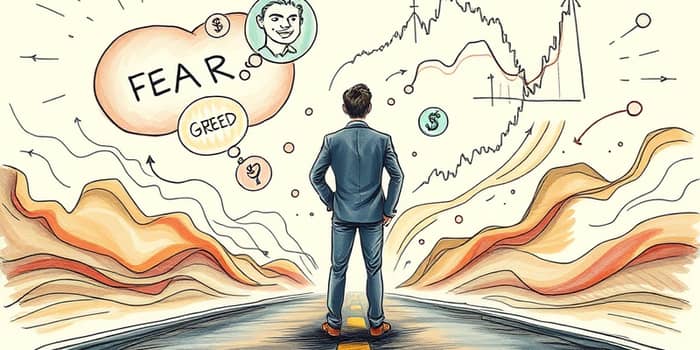Every day, investors confront a jumble of data, news, and gut feelings that drive their financial choices. While classical theories assume perfectly rational decisions, real-world behavior often deviates due to subconscious influences. Behavioral finance reveals hidden forces that shape our actions, illuminating why markets sometimes overreact or tumble unpredictably.
In this article, we explore how understanding these patterns empowers you to make wiser decisions, avoid costly pitfalls, and cultivate a resilient long-term strategy.
Definition and Core Concepts
Behavioral finance merges two disciplines: economics and psychology. It studies how emotions, cognitive biases, and social factors lead people to make investment decisions that stray from purely objective logic.
Traditional finance models assume that actors always seek to maximize returns based on probabilities, with markets instantly reflecting all available information. Yet empirical evidence shows recurrent anomalies like price bubbles and panicked sell-offs, revealing a gap between theory and practice.
Historical Context and Prominent Figures
The seeds of behavioral finance were sown in 1912 with George Seldon’s “Psychology of the Stock Market,” but the field truly crystallized in 1979 when Daniel Kahneman and Amos Tversky published their groundbreaking work on decision-making under uncertainty. Their experiments demonstrated systematic biases in human judgment, earning Kahneman a Nobel Prize in Economics in 2002.
Later, Richard Thaler introduced the concept of mental accounting among everyday individuals. He showed that people categorize money into separate accounts—treating a tax refund differently from a regular paycheck—leading to irrational allocation of resources.
Main Behavioral Biases and Heuristics
Investors regularly fall prey to cognitive shortcuts designed to simplify complex decisions. While these heuristics can speed up judgment, they often introduce distortions that erode returns or amplify risk.
Applications: Individual and Institutional Perspectives
Understanding biases is essential for both private investors and large financial institutions. On a personal level, money-related behaviors often reflect deep-seated psychological drivers rather than pure arithmetic.
- Overspending on credit cards or failing to save consistently due to immediate gratification, even when retirement needs loom.
- Panic selling during abrupt market downturns fueled by heightened anxiety and loss aversion, undermining long-term wealth goals.
- Professional asset managers integrating behavioral insights into portfolio construction, using client education to mitigate anchoring and overconfidence.
Behavioral Finance in Action: Case Studies
COVID-19 Market Crash: In early 2020, unprecedented uncertainty led to widespread impulsive selling. Even seasoned investors surrendered to panic, showcasing how loss aversion and recency bias can dominate in crisis.
Warren Buffett’s Coca-Cola Investment (1988): At a time when many feared a protracted downturn, Buffett’s contrarian approach and patience paid off. He resisted herd numbers and emotional noise, demonstrating the power of contrarian value investing.
“Mark” in a Downturn: A hypothetical case of a disciplined planner who nearly abandoned his strategy during a sharp decline. By recognizing his own recency bias, he avoided selling at rock-bottom levels and later benefited from the market rebound.
Practical Strategies to Manage Biases
Arming yourself with tools and processes can dramatically improve decision quality. Neutralizing emotional impulses requires concerted effort and structure.
- Self-Awareness: Keep a decision journal to review past choices and identify recurring biases.
- Education: Learn about common pitfalls and recognize them in yourself through quizzes and peer discussions.
- Data-Driven Analytical Approaches: Use checklists, algorithmic screening, or AI tools to reduce emotional interference.
- Frame Decisions in Decades: Adopt a long-term perspective to counteract recency bias and impulsive shifts.
- Diversification: Spread risk to avoid overconfidence in single stocks or sectors.
Recent Trends and Technological Integration
In today’s fast-moving markets, advanced technologies are enhancing behavioral insights. AI and machine learning algorithms now monitor trading patterns in real time, issuing nudges when emotional trading spikes beyond historical norms. Financial apps integrate prompts to remind users of their long-term goals before executing trades, weaving behavioral science into everyday tools.
Institutions deploy personalized content, helping clients recognize when they lean too heavily on one bias or another. By blending behavioral frameworks with big data, the industry is forging new frontiers in investor protection and performance enhancement.
Key Takeaways and Importance
Behavioral finance bridges the gap between theory and human reality, revealing why markets swing wildly and individuals sometimes act against their best interests. By learning to spot biases, adopt structured processes, and leverage modern technology, investors can reduce emotional errors and capture more consistent returns.
Ultimately, understanding the psychology underpinning your choices transforms investing from a roller coaster of highs and lows into a disciplined journey toward long-term prosperity.
Embrace these insights today to craft financial decisions guided by both rational analysis and self–awareness, unlocking the full potential of your capital over the decades ahead.
References
- https://www.indeed.com/career-advice/career-development/behavioral-finance
- https://www.iibsonline.com/case-study-details/the-impulse-to-sell-a-behavioral-finance-case-study
- https://www.ebsco.com/research-starters/economics/behavioral-finance
- https://www.meegle.com/en_us/topics/behavioral-finance/behavioral-finance-case-studies
- https://www.hbs.edu/faculty/Pages/item.aspx?num=34176
- https://online.mason.wm.edu/blog/what-is-behavioral-finance
- https://enrichpartners.com/blog/covid-19-created-the-perfect-case-study-in-behavioral-finance-heres-what-we-mean










